The SSD Relapse: Understanding and Choosing the Best SSD
by Anand Lal Shimpi on August 30, 2009 12:00 AM EST- Posted in
- Storage
What's Wrong with Samsung?
The largest SSD maker in the world is Samsung. Samsung makes the drives offered by Apple in its entire MacBook/MacBook Pro lineup. Samsung makes the drives you get if you order a Lenovo X300. In fact, if you're buying any major OEM system with an SSD in it, Samsung makes that drive.
It's just too bad that those drives aren’t very good.
This is the 4KB random write performance of Samsung's latest SSD, based on the RBB controller:
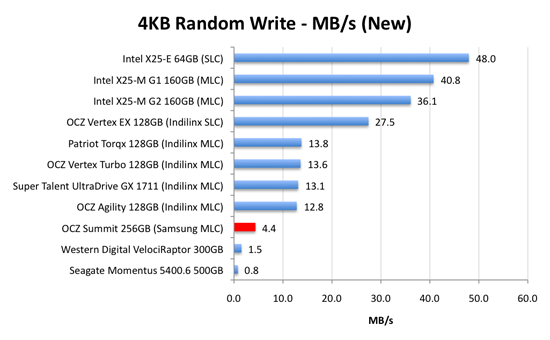
4.4MB/s. That's 3x the speed of a VelociRaptor, but 1/3 the speed of a cheaper Indilinx drive.
Speedy, but not earth shattering. Now let's look at performance once every LBA has been written to. This is the worst case scenario performance we've been testing for the past year:
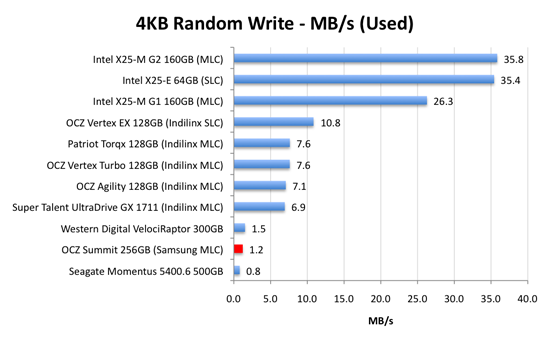
...and now we're down to mechanical hard drive speeds
Holycrapwtfbbq? Terrible.
Now to be fair to Samsung, this isn’t JMicron-terrible performance. It’s just not worth the money performance.
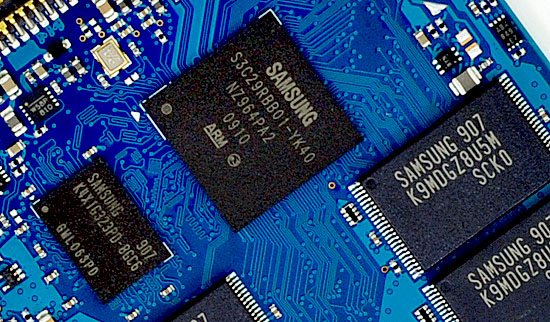
The Samsung RBB based SSDs are rebranded by at least two manufacturers: OCZ and Corsair.
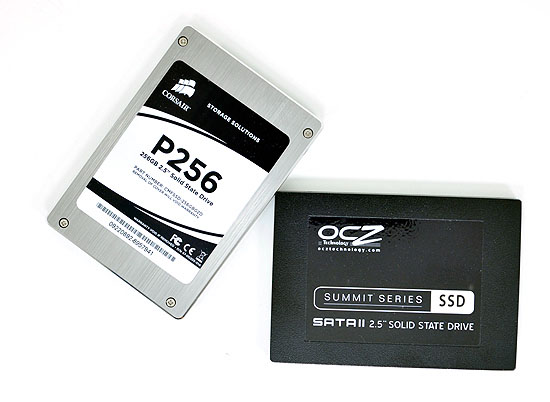
The OCZ Summit and the Corsair P256 both use the Samsung RBB platform.
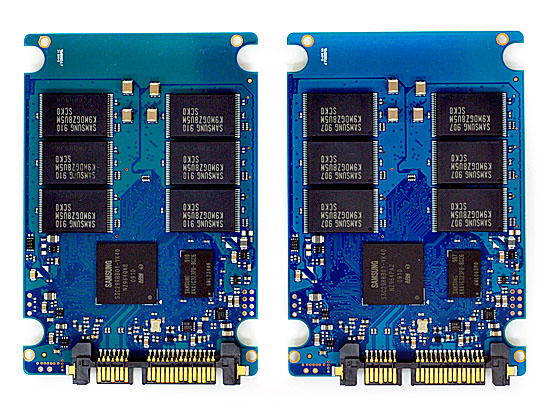
The Corsair and OCZ Samsung RBB drives.
The drive most OEMs are now shipping is an even older, lower performing Samsung SSD based on an older controller.
I talked to some of the vendors who ship Samsung RBB based SSDs and got some sales data. They simply can’t give these drives away. The Indilinx based drives outsell those based on the Samsung RBB controller by over 40:1. If end users are smart enough to choose Indilinx and Intel, why aren't companies like Apple and Lenovo?
Don't ever opt for the SSD upgrade from any of these OEMs if you've got the option of buying your own Indilinx or Intel drive and swapping it in there. If you don't know how, post in our forums; someone will help you out.
Samsung realized it had an issue with its used-state performance and was actually the first to introduce background garbage collection; official TRIM support will be coming later. Great right? Not exactly.
There’s currently no way for an end user to flash the firmware on any of these Samsung drives. To make matters worse, there’s no way for companies like OCZ or Corsair to upgrade the firmware on these drives either. If you want a new firmware on the drive, it has to go back to Samsung. I can’t even begin to point out how ridiculous this is.
If you’re lucky enough to get one of the Samsung drives with background garbage collection, then the performance drop I talked about above doesn’t really matter. How can you tell? Open up Device Manager, go to your SSD properties, then details, then select Hardware Ids from the dropdown. Your firmware version will be listed at the end of your hardware id string:
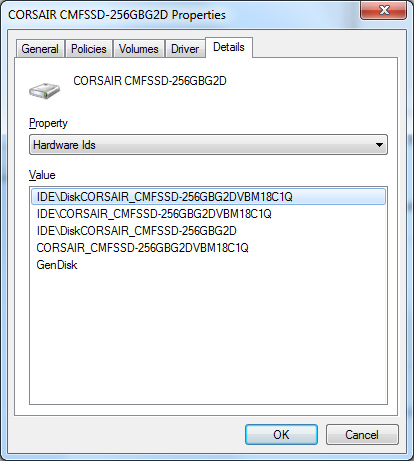
Version 1801Q doesn’t support BGC. Version 18C1Q (or later) does.
How can you ensure you get a model with the right firmware revision? Pick a religion and start praying, because that’s the best you can do.
Now the good news. When brand new, the Samsung drives actually boast competitive sequential write, sequential read and random write speeds.
These drives are also highly compatible and very well tested. For all of the major OEMs to use them they have to be. It’s their random write performance that’s most disappointing. TRIM support is coming later this year and it will help keep the drives performing fresh, but even then they are still slower than the Indilinx alternatives.
There’s no wiper tool and there’s currently no method to deploy end-user flashable firmware updates. Even with TRIM coming down the road, the Samsung drives just don’t make sense.










295 Comments
View All Comments
tachi1247 - Friday, September 18, 2009 - link
Does anyone know what the difference is between the 7mm thick and 9.5mm thick drives?http://download.intel.com/design/flash/nand/mainst...">http://download.intel.com/design/flash/nand/mainst...
They seem to be identical except for the drive thickness.
dszc - Saturday, September 12, 2009 - link
FANTASTIC series of articles. Kudos! They go a long way toward satisfying my intellectual curiosity.But now it is time to reap the rewards of this technology and earn a living.
So I need some real-world HELP.
How do I clone my 320GB (80GB used) Hitachi OS drive (Vista 32 SP2) over to a 128GB Indilinx Torqx?
All I really care about is Photoshop and Bridge CS4 performance. I am a pro and work 4-16 hours per day in Bridge and Photoshop, with tens of thousands of images, including 500MB - 2GB layered TIFFs. The Photoshop Scratch Disk and Bridge and CameraRaw Cache performance are killing me. Solid State Storage seems to be the perfect solution to my problem
I really want to simply clone my 320 over to the Torqx, because it would take me a week to re-install and configure all of my software and settings that are now on the 320GB Hitachi.
Do I just bring the Torqx up in the Vista Storage Disk Management, initialize it with one big partition, and then format it?
What size allocation unit should I use? :
Default? 4096? 64k? ???
Will these settings be wiped out when I clone over the stuff from the old hard drive?
What about "alignment"?
What is the best software for a SIMPLE & painless clone procedure?
I'm not a techie or geek, but have a fair working knowledge of computers.
Any help would be hugely appreciated. Thanks.
userwhat - Thursday, September 17, 2009 - link
I use Drive Snapshot for all these purposes. It works 100%, it´s a very small and fast program. After having issues with Norton Ghost and some other similar programs which were absolutely unable to restore an imaged partition stored on a DVD this is THE one to use.Get it here: http://www.drivesnapshot.de/en/">http://www.drivesnapshot.de/en/
dszc - Saturday, September 26, 2009 - link
Thank you very much for your help and recommendations.To get my Patriot (SolidStateStorage) up and running, I used Seagate DiskWizard (an Acronis subset), as I have lots of Seagate drives already on my system and this free software seems to work.
When I get a window of time in my schedule, I'll try DriveSnapShot and/or DriveImage to see if they do a better job in helping my Torqx SSS run at its full potential.
Thanks again for your help.
Dave
JakFrost - Tuesday, September 15, 2009 - link
If you want to image out your current drive and migrate over to an SSD you can use the free software below that works with Windows Volume Shadow Copies to do a online live migration to another drive without losing or corrupting your data. This means that you can do this from the same OS that you are running.This software will allow you to image out to an already created partition that is already aligned at the 1MB boundry that is standard for Microsoft Vista/7 operating systems.
DriveImage XML V2.11
English (1.78MB)
Image and Backup logical Drives and Partitions
Price: Private Edition Free - Commercial Edition - Buy Now Go!
System Requirements: Pentium Processor - 256 MB RAM
Windows XP, 2003, Vista, or Windows 7
An alternative is to use an offline migration system such as Acronis TrueImage, Norton Ghost, etc. to do the migration offline from a bootable CD or USB drive. Search around for Hiren's BootCD to check out these and other tools to do the migration.
dszc - Saturday, September 26, 2009 - link
Thank you very much for your help and recommendations.To get my Patriot (SolidStateStorage) up and running, I used Seagate DiskWizard (an Acronis subset), as I have lots of Seagate drives already on my system and this free software seems to work.
When I get a window of time in my schedule, I'll try DriveImage and/or DriveSnapShot to see if they do a better job in helping my Torqx SSS run at its full potential.
Thanks again for your help.
Dave
jgehrcke - Friday, September 11, 2009 - link
Be careful when buying a Super Talent UltraDrive GX 128 GB with "XXXX" in serial number (unfortunately you cannot check this before ordering the drive). These drives are much slower than measured in the benchmark here and in other benchmarks.For more information and related links see
http://gehrcke.de/2009/09/performance-issue-with-n...">http://gehrcke.de/2009/09/performance-i...est-supe...
Kitohru - Thursday, September 10, 2009 - link
Does OS X Snow Leopard have trim support, and if not any word from apple about that or the like?Zool - Thursday, September 10, 2009 - link
I still dont think that with this price ssd-s will be more mainstream in the next years. And honestly the performance is not even that extra if everything would work like it should. The mechanical drives can reach now 100 MB reads when things are optimal. The small files performance is still only software problem. U should never ever reach point when u need to randomly find 4 KB files in a long row. With todays ram capacity and cpus-s programs should never read such small files or group things in larger files and read whole to memmory. A solid today programed aplication (let it be game or programs) should never let your disk spam with 30k files (like catia or other plenty of aged so called "profesional" programs). With today ram and disk capacity it should read things to memmory and let only grouped larger files on disk and never ever touch the hdd again until users isnt comunicating with the software (u can tell it to windows).Saves can be made to memmory and than write to disk without even seeing a fps drop in games(not just games) becouse of disk comunication latenciI dont even think the IO performance would be a problem with the RIGHT software and OS. With 100MB reads it could run perfectly fine with few seconds loading times. Even the latencies of ssd-s are no match to ram latencies so everithing that should activly comunicate with disks (which is just stupid with curent ram prices and 64bit) would just level your latencies down to disks.
Why should worry about latencies and read speeds when u could copy it to ram and keep the files on disk in shape where the mechanical drive
should never find itself to read files smaller than few MB.(even your
small txt documents u can hide in archive).
Just my toughs. (sorry for my english)
AlExAkE - Wednesday, September 9, 2009 - link
Hey, I'm a web & multimedia designer. I spend lots of my time using most of the Adobe CS4 products including Photoshop, Flash, Dreamweaver, Illustrator, After Effects & Premiere Pro.The Intel 80GB G2 looks amazing, but the Photoshop test is awful because of his write speed. The Intel 25-Extreme series seem to be the best but is to pricey. The OCZ Vertex has good write speed but is slower than Intel G2 in most of the test. What would be the recommended SSD for my purpose. Thanks